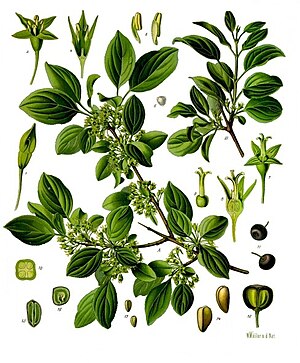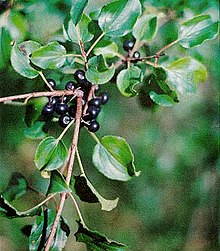Purgier buckthorn
| Purgier buckthorn | ||||||||||||
|---|---|---|---|---|---|---|---|---|---|---|---|---|

Purgier buckthorn ( Rhamnus cathartica ), illustration |
||||||||||||
| Systematics | ||||||||||||
|
||||||||||||
| Scientific name | ||||||||||||
| Rhamnus cathartica | ||||||||||||
| L. |
The Purgier buckthorn ( Rhamnus cathartica , Syn .: Rhamnus catharticus L. ) is a species of the family of buckthorn plants (Rhamnaceae). It is a plant native to Eurasia and North Africa and, for example, invasive in North America .
Naming
The Purgier buckthorn also has the following other common names : Purgierdorn , Purgierstrauch , Kreuzbeerstrauch , Kreuzdorn , Real Buckthorn , Wegedorn or Real Wegedorn . The name buckthorn comes from the twigs or thorns that are sometimes in a cross, the name purging thorn (purging: to carry away) from the poisonous fruits with their laxative effect.
description
The purge buckthorn grows as a bulky, deciduous shrub and reaches heights of 3 meters or as a small tree up to 6 meters, as such it can reach an age of around 100 years. The bark of the buckthorn is smooth and only shows a few cracks with age. He has thorns that gave him his German name. The almost opposite leaves are 3 to 7 centimeters long.
The flowering period extends from May to June. The flowers form in clusters. The Purgier buckthorn is dioecious, separate sexes ( diocesan ); In one of the flowers there are rudiments of the opposite sex, with the male flowers still showing stunted remains of ovaries and the female flowers still have rudimentary stamens. The male flowers are larger. The styles are of different lengths ( heterostyly ). The inconspicuous, green flowers are radial symmetry and four-fold.
The spherical with a diameter of 6 to 8 mm, at maturity black-violet drupes contain three or four triangular casts.
The number of chromosomes is 2n = 24.
ecology
The flowers are inconspicuous, "nectar-bearing disc flowers". The nectar is given off openly from a discus. The pollination is done especially by flies and Hymenoptera .
Digestive dissemination takes place through birds . Fruit ripening takes place from September to October.
Vegetative propagation occurs through root shoots.
Occurrence
The distribution area of the Purgier buckthorn covers almost all of Europe and extends from northwest Africa to western Asia .
The buckthorn loves lime, but is otherwise pH-indifferent. It can be found in alluvial forests, hedges and roadsides as well as on rocky slopes. It is widespread in Germany - from the North German lowlands to the Alps at altitudes of 1,600 meters. The preferred location is in the shrub layer at a height of up to 800 meters above sea level. It is a Berberidion association character in Central Europe, but also occurs in societies of the order Quercetalia pubescenti-petraeae.
Pests
The Purgier buckthorn is an intermediate host of the orange oat crown rust ( Puccinia coronata ), which is an important pest of grain and forage grasses. It is also a food plant for the caterpillars of the lemon moth ( Gonepteryx rhamni ) and for those of the sea buckthorn ( Philereme transversata ).
use
The dried fruits are used as a laxative ; on the other hand, the consumption of unripe fruit - especially in children - can lead to symptoms of poisoning . The shrub owes its botanical name cathartica (ancient Greek: katarthikos for cleansing) to its laxative effect .
In the past, the painters used the fruit to make the “sap green” and the dried berries, ground in a mortar, were used as a watery extract to make a yellow dye for staining wood (15th - 17th centuries).
Toxicity
The fruits are very poisonous. The bark is just as toxic to humans.
swell
- Ruprecht Düll , Herfried Kutzelnigg : Pocket dictionary of plants in Germany and neighboring countries. The most common Central European species in portrait. 7th, corrected and enlarged edition. Quelle & Meyer, Wiebelsheim 2011, ISBN 978-3-494-01424-1 .
Individual evidence
- ↑ a b c Erich Oberdorfer : Plant-sociological excursion flora for Germany and neighboring areas . 8th edition. Verlag Eugen Ulmer, Stuttgart 2001, ISBN 3-8001-3131-5 . Page 652.
- ↑ Klaus Kugi: Recognize, collect and use medicinal plants . Neuer Kaiser-Verl., Fränkisch-Crumbach 2012, ISBN 9783846800171 .
- ↑ Sam Allen, translated by Günther Heine: Surface treatment of wood: Classic techniques and recipes (Classic finishing techniques) . Th. Schäfer, 2005, ISBN 3-87870-586-7 .
Web links
- Purgier buckthorn. In: FloraWeb.de.
- Profile and distribution map for Bavaria . In: Botanical Information Hub of Bavaria .
- Rhamnus cathartica L. In: Info Flora , the national data and information center for Swiss flora . Retrieved December 6, 2015.
- Distribution in the northern hemisphere according to Eric Hultén
- Thomas Meyer: Data sheet with identification key and photos at Flora-de: Flora von Deutschland (old name of the website: Flowers in Swabia )
- Profile with photos at Baumkunde .
- Ingredients of the purge buckthorn at Giftpflanze.comPendium .
- Short profile (right) at Das Lehrbiotop . (PDF file; 12 kB)




